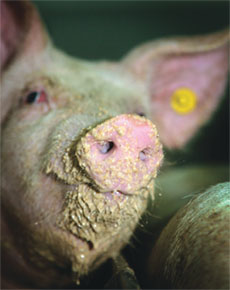By: Emmy Koeleman
The use of liquid feeds in animals has created an opportunity for recycling of liquid co-products from the human food industry especially in the European pig industry. This has considerably reduced the need for alternative methods of disposal of these products, like drying, disposal to land fill or burning. However, liquid feeds have the potential to serve as potent reservoirs of enteropathogens unless steps are taken to prevent their introduction and proliferation during storage and feeding. It is also well known that liquid-feeding systems can easily become contaminated. This is where the use of lactic acid bacteria comes in. The lactic acid bacteria create an accelerated fermentation of the feed and hence reduce the possibility of contamination by enteropathogens. In addition, the bacteria also have a stimulating effect on the gut health of the animals, which in turn helps keeping them healthy.
Effect of Fermentation
Liquid feeding for pigs can be done by using nonfermented liquid feed or
fermented feed. When using the non fermented form, water is added to the mixed feed. When using fermentation, the feed and water are mixed and then stored at a certain temperature and for a period of time prior to feeding it to the animals. Danish researchers (2007) have studied the microbial and nutritional characteristics of dry feed, liquid feed containing fermented liquid cereal grain, and fermented liquid compound feed, and their effect on gastrointestinal ecology and growth performance of piglets. Three dietary treatments were designed: dry feed (DRY); fermented liquid cereal grain feed (FLG); and fermented liquid feed (FLF). The FLF was prepared by removing three times daily 50% of the mixture (feed and water) stored in a tank at 20 °C and replacing it with an equal amount of fresh feed and water. The FLG was similarly prepared but fermenting only the cereals (barley and wheat) and adding the remaining ingredients immediately before feeding. One hundred and twenty weaners were fed the diets during 6 weeks from weaning. The dietary content of lysine (g/100 g protein) was 6.01 in the DRY diet, 6.21 in the FLG diet, and 5.46 in the FLF diet.
Feeding piglets with the FLG diet resulted in a higher density of yeasts, a higher concentration of ethanol in the gastrointestinal tract and a change of the bacterial population of the stomach compared to feeding FLF. The FLG group had a numerically higher daily feed intake and daily body weight gain compared to the FLF group, but the values were not significant.
Gut Ecology
Another study was carried out to find out what the effects on gut ecology are when feeding fermented liquid feed (FLF). The Japanese and UK research team investigated the effect of three diets, standard dry feed (control), dry feed supplemented with antibiotics, and fermented liquid feed (FLF, fermented with Lactobacillus plantarum), on gut bacterial diversity in piglets. The structure of the ileal and caecal communities was estimated by sequencing the SSU rRNA gene libraries. Antibiotic-supplemented feed slightly increased bacterial diversity in the ileum but reduced it in the caecum while in FLF-fed animals bacterial diversity was elevated. The
majority of bacterial sequences in the ileum of all three groups belonged to lactobacilli (92–98%). In the caecum the lactobacilli were still dominant in control and antibiotic-fed animals (59% and 64% of total bacterial sequences, respectively) but in FLF-fed animals they fell to 31% with the concomitant increase in the Firmicutes diversity represented by the Dorea, Coprococcus, Roseburia and Faecalibacterium genera. It can be concluded that FLF affects the gut ecology in a different way than antibiotics and contributes to the enhanced bacterial diversity in the gastrointestinal tract.
Conclusion
Fermented liquid feed has been investigated lately in order to compensate the use of antibiotics in pig production. Fermenting a liquid diet with lactic acid bacteria has been shown to improve the quality of feed and to be beneficial to the health of the animals. The use of liquid feeds in animals has created an opportunity for recycling of liquid co-products from the human food industry especially in the European pig industry. However, contradictory results have been obtained in feeding trials due to the variable conditions in each experiment. <-
Kenneth Cameron, general manager of a fattener farm in Goondiwindi, Australia. “We installed a liquid fermentation system about a year ago, but soon after the installation, we found out that we couldn’t get the temperature low enough to ensure optimum fermentation of the liquids, explains Cameron. Ideally, the fermented liquid feed should be around 23 degrees Celsius but the Australian farm struggles with getting the temperature below 27 degrees in summertime.
The right temperature in the tank is critical to get only the lactobacillus bacteria growing. At a higher temperature level, unwanted substances get into the feed, such as propionic acid. “We therefore made the decision not to use the fermentation process, but just to stick with normal liquid feeding” says Cameron. The fermentation tanks have found another destination now; they were turned into water storage tanks. Being located in a hot climate doesn’t necessarily mean that fermented liquid feed is not an option. There are many successful applications of these types of feeding systems in hot regions in the US and Asia.
Pros and cons of fermentation Pros Lower costs of feed, acid and animal medicines Better technical results as in lower mortality, better growth, lower feed conversion Better health because there are fewer pathogens in the gut Good for the environment because less phosphorus (P) can be added because P is better absorbed in fermented feed Cons Extra costs for adaptation to the system (machines, lactic acid meter and the lactic acid itself) Fermentation is an art and can fail Not all types of feed can be used in the system. This limits the choice of raw materials [source: Boerderij (2009)] |
Source: Feed Mix magazine Volume 17 No. 6












